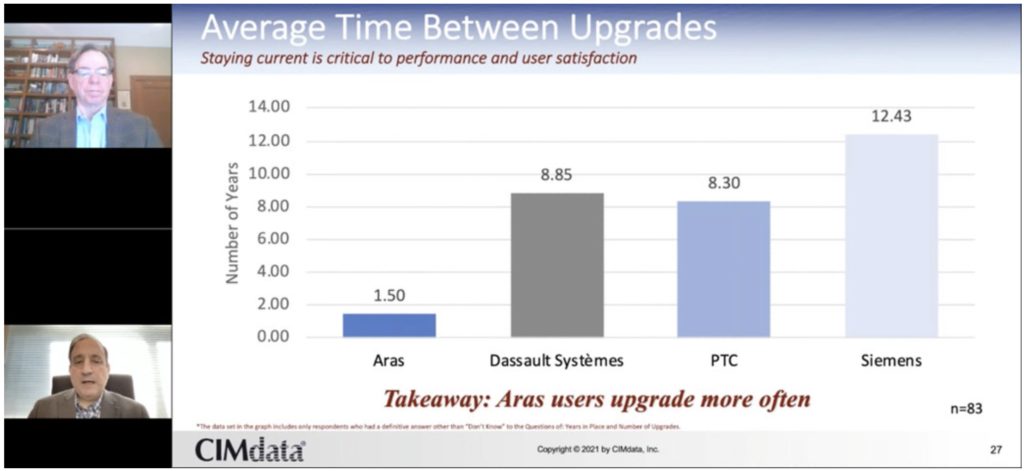
I spent some time this weekend catching up on PLM news and publications. The following post from Jenifer Moore at Minerva caught my attention, The post speaks about the topic of PLM upgrades, presented in one of the recent CIMdata researches shows a comparison between Aras, Dassault, PTC, and Siemens PLM upgrades. Check the links in the article. Also, don’t miss the Engineering.com article by Lionell Grealou providing a critical review of the study. I captured the following 2 screenshots, but you can find more in the articles.


The topic of PLM upgrades usually raises many questions. I’m sure, looking at the charts you can ask yourself how to compare such a complex process as PLM implementation, especially done for large manufacturing enterprises using these PLM systems. Even more interesting question is related to the upgrade trend in the industry and benchmarks can be used to check your PLM environment and spending for upgrades.
PLM Architecture
Understanding what PLM upgrade is in technical terms can have a major impact on what to measure and how to count what you do. These days, PLM systems can be delivered in a variety of forms – on-premise, hosted, or SaaS. Each of these environments has its own pros and cons as well as details and range from complex on-premise environments with the upgrade that requires setting up a new environment for testing to a very agile container-based hosted system that can be replaced automatically without the customer even having a notice.
While technically upgrades can be done seamlessly for the SaaS environments, the question about customization and specific implementations compatibility are usually raised by customers. The trend towards SaaS or container-based hosted environments simplifies everything, the real question is about compatibility between versions and functions. Most SaaS systems are single-source platforms that run upgrades very often and don’t take any cost to customers. I expect the trend to continue.
Data Models, APIs, and compatibility
Digging more deep into system architecture, you want to learn how flexible data management of PLM platform is and how it can impact the future upgrades, Adding data elements, customizing existing workflow behaviors and user experience – all these parameters can impact how the system will sustain upgrades and changes.,
Having the system configuration setting independent, backward compatibility of APIs and data modeling abstraction levels can simplify the upgrades. PLM implementation best practices can impact what will be the cost of the upgrade. For example, a practice of SQL programming and direct access to databases for on-premise PLM installation can cost you a lot in future upgrades. Heavily customized process logic dependent on data managed by the system can be another source. At the same time, the SaaS environment, which provides a backward-compatible API as well as an ability to upgrade the system in minutes with a backward test of data, can take the cost down substantially.
Business
It is important to separate the cost of upgrade and differentiate between vendor cost and customer cost. PLM upgrade is a big problem in the industry. The recent practice from some PLM vendors is to include upgrades in the subscription costs. When it is done, it becomes hard to compare the cost of the upgrade. The upgrade cost of a SaaS system can be zero. But in some cases can include testing of the system in the sandbox environment. For on-prem systems, the cost of infrastructure upgrades and customizations itself can be substantial.
The purpose of PLM upgrade can be different from installing service packs, security patches, database upgrades on one side and on the other side, introducing new major releases with redefined functions and features in the data model, processes, and integrations. The last one (integrations) are often a separate topic in the upgrades. Integrations introduce a new dimension in upgrade complexity.
What is my conclusion?
I can see the trend towards the simplification of PLM upgrades to continue in the industry. SaaS and cloud technologies bring new levels of technical capabilities and lead to better solutions from both technical and business standpoints. Advanced SaaS infrastructures and products will be introducing more capabilities and lead to simplifications of PLM upgrades geared towards various deployment architectures – SaaS, hosted, and on-premise. SaaS architecture will become dominant in the near future, security requirements and complex distributed IT infrastructure oriented on service architecture will raise the awareness and the need to simplify upgrades in all systems. Just my thoughts…
Best, Oleg
Disclaimer: I’m co-founder and CEO of OpenBOM developing a digital network-based platform that manages product data and connects manufacturers, construction companies, and their supply chain networks. My opinion can be unintentionally biased.
The post PLM Upgrades Trends appeared first on Beyond PLM (Product Lifecycle Management) Blog.



Be the first to post a comment.